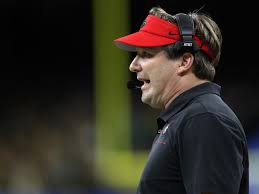When it comes to college football, the Southeastern Conference (SEC) often evokes a mix of awe, envy, and debate. For years, the SEC has been widely recognized as the premier conference in the sport, producing multiple national champions and sending more players to the NFL than any other league. Yet, despite all the headlines and championships, there’s a critical perspective that many fans, analysts, and even other conferences overlook — the deeper narrative and strength of the SEC beyond just the most obvious powerhouse: the Alabama Crimson Tide. Recently, Georgia Bulldogs head coach Kirby Smart explicitly name-dropped Alabama to highlight exactly what people are missing about the SEC’s true value and what the conference represents in college football.
Kirby Smart, a former assistant coach under Nick Saban at Alabama before taking the helm at Georgia, speaks from a place of intimate knowledge and experience. His understanding of both programs — two of the SEC’s most dominant forces — lends considerable weight to his insights. Smart’s comments remind the college football community that the SEC is not merely about one team or a single dynasty, but a broader ecosystem of competition, tradition, development, and excellence.
At its core, what Kirby Smart is underscoring is a fundamental truth: the SEC’s identity and impact transcend the banners hanging in Tuscaloosa. While Alabama’s success story is well documented and celebrated, it is only one chapter in a much larger book. The conference is a crucible of relentless competition where the margin for error is razor-thin, and every game carries weight. This environment fosters a level of preparation, physicality, and strategic innovation that is unmatched elsewhere in college football.
One key element Smart highlights by referencing Alabama is the standard of excellence the Crimson Tide represents. Alabama is not just a team that wins; it’s a program that embodies a blueprint for sustained success. From the meticulous recruitment process, the player development pipeline, the coaching acumen, to the culture of discipline and accountability, Alabama sets a benchmark that raises the entire conference’s bar. For Smart, Alabama exemplifies what makes the SEC a powerhouse — a relentless pursuit of greatness that pushes every program within the league to elevate their game.
Moreover, Smart points out that focusing solely on Alabama overlooks the deep talent pool and competitive balance within the SEC. The conference boasts several nationally ranked programs that consistently challenge the Tide’s dominance. Georgia, LSU, Florida, Texas A&M, and others have invested heavily in recruiting, facilities, and coaching, ensuring the league remains fierce and unpredictable. The presence of Alabama forces these programs to innovate and improve continually, which ultimately benefits the conference as a whole.
Smart’s remarks also address a broader narrative that sometimes undercuts the SEC’s reputation. Critics often attribute the conference’s success primarily to physical dominance or superior athletes, but Smart hints at a more nuanced picture. The SEC’s strength also lies in its sophisticated coaching, game-planning, and adaptability. Alabama is a prime example of this — Nick Saban’s coaching philosophy, attention to detail, and ability to adjust mid-game have become legendary. Smart himself has adopted many of these principles, which he has leveraged to lead Georgia to national prominence. This intellectual approach to the game, paired with elite talent, creates a holistic model that defines SEC football.
Another aspect Smart emphasizes is the cultural significance of the SEC and Alabama’s role within that culture. Football in the SEC is not just a sport; it’s a social institution deeply embedded in the fabric of the region. The passion of the fans, the traditions that span generations, and the pressure to uphold a legacy create an environment unlike any other. Alabama is the flagship program of this culture, symbolizing the pinnacle of what it means to compete in the South. Understanding this cultural context is vital to appreciating why the SEC matters so much and why it commands such respect nationally.
Smart also challenges the notion that the SEC’s dominance is guaranteed or static. By using Alabama as an example, he highlights the intense internal competition that keeps the conference on its toes. Every season, teams within the SEC bring their best efforts to dethrone the Crimson Tide, leading to some of the most thrilling and high-stakes matchups in college football. This internal rivalry ensures that complacency has no place and that each program must constantly evolve. For Smart and others in the conference, Alabama serves as both a benchmark and a motivator — the yardstick by which success is measured and the challenge that pushes everyone forward.
Importantly, Smart’s perspective invites a reassessment of how the SEC is viewed by outsiders. Rather than reducing the conference’s identity to a single dominant team, he encourages recognition of the collective strength and competitiveness. The narrative should shift from “Alabama is the SEC” to “The SEC is a league of elite programs, each striving to match or surpass the level set by Alabama.” This reframing gives credit to the conference’s depth and the remarkable quality of football played week in and week out.
Furthermore, Smart’s insights shed light on the broader implications for college football’s landscape. The SEC’s model — driven by rigorous competition, investment in resources, and a culture of winning — serves as a blueprint for others seeking to elevate their programs. The Alabama example is instructive not just for the conference but for the entire sport, illustrating how a commitment to excellence across all dimensions can create a sustainable powerhouse. It also underscores the importance of leadership, vision, and consistency in building a program that can weather the ebbs and flows of college athletics.
At the same time, Smart acknowledges the challenges that come with the spotlight on Alabama. The Tide’s success often overshadows other narratives within the conference, making it harder for other programs to receive recognition. This dynamic can create a perception that the SEC lacks parity or diversity in competition, which is misleading. Smart’s call to look beyond Alabama is a call to appreciate the full spectrum of the SEC’s strength — the emerging stars, the gritty underdogs, and the programs on the rise. This holistic view enriches the understanding of what the conference truly represents.
Moreover, Smart’s reflections come at a critical juncture in college football history. The sport is undergoing significant changes with expanded playoffs, transfer portal dynamics, NIL deals, and evolving media landscapes. In this context, the SEC’s ability to maintain its dominance while adapting to new realities will be tested. The Alabama model, which Smart points to, offers valuable lessons in resilience and innovation. It shows how a program and a conference can thrive by staying true to core principles while embracing change.
Kirby Smart’s name-dropping of Alabama is not just a nod to a rival or a well-known powerhouse. It is a deliberate strategy to spotlight the deeper qualities that define the SEC. He uses Alabama as a mirror reflecting what the conference as a whole embodies — excellence, competition, culture, and leadership. Through this lens, fans and analysts are urged to broaden their appreciation and look beyond headlines to grasp the full story of SEC football.



